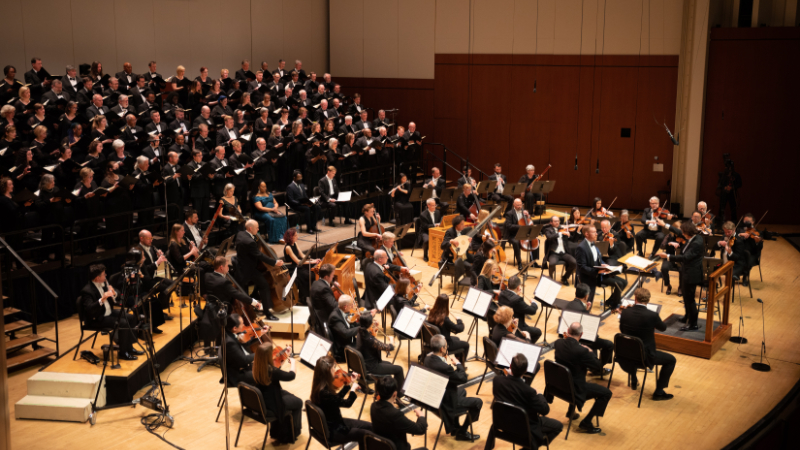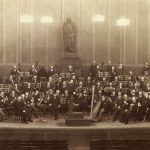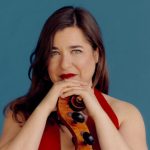March 30, April 1 & 2, 2023
Atlanta Symphony Hall, Woodruff Arts Center
Atlanta, Georgia – USA
Nathalie Stutzmann, conductor; Robin Tritschler (Evangelist); Nmon Ford (Jesus); Camilla Tilling, soprano; Lucia Bradford, mezzo-soprano; Kenneth Tarver, tenor; Leon Košavić, baritone; ASO Chorus (including 8 assisting soloists from within the Chorus; Spivey Hall Children’s Choir; Continuo players: Annalisa Pappano, viola da gamba; Alice Coquart, continuo cello; Chloé Sévère & Peter Marshall, continuo keyboards; Jonas Nordberg, theorbo; Joseph McFadden, bass; Anthony Georgeson, bassoon.
Johann Sebastian BACH: Matthäus-Passion (St. Matthew Passion), BWV 244
Mark Gresham | 1 APR 2023
Writing this review is gut-wrenching. It’s not the review I wanted to write. But it’s the review I must pen as an obligation to be honest with readers, however old-fashioned that may sound in today’s world of journalism. I am not the kind of critic who is searching for blood. And I should note also have a long-time affinity for Bach’s St. Matthew Passion, having first learned it from the inside as a young tenor chorister some half-century ago.
I had hoped that this bellwether concert would prove a stabilizing factor in developing a positive perception of the Atlanta Symphony Orchestra’s directions and artistic leadership under music director Nathalie Stutzmann, who is still in her first official season at the orchestra’s helm. I couldn’t have been more wrong.
This St. Matthew Passion incited even more skepticism for me than Stutzmann’s performance of Beethoven’s 9th Symphony (October 2022, her official debut as music director) and of Brahms’ Third Symphony (also that same October).
But let’s turn here the commendable elements in the performance and work our way down.
At the top of the list are the two vocal soloists placed at the front of the orchestra, although still upstage from the conductor’s podium: baritone Nmon Ford, with his round-toned voice, was excellent in portraying Jesus, even if, from my seat in orchestra left, he was pretty much invisible behind Stutzmann; Robin Tritschler was commendable as the Evangelist, with the kind of tenor voice you would typically expect in the role, notably with attention to nuanced vocalization of his sung narrative that is the oratorio’s connective glue.
The other quartet of principal soloists, soprano Camilla Tilling, mezzo-soprano Lucia Bradford, tenor Kenneth Tarver, and baritone Leon Košavić, all credible in their respective performances, were unfortunately positioned center behind the orchestra and in front of the choruses, much was to their disadvantage, as it was for the soloists in the ASO’s March 2022 performance of Mozart’s Requiem, although not quite as much so.
The quartet of soloists is crucial because they are not just four voices with different voice ranges; they are also four personalities observing and responding to the progress of the Passion drama. They ought to be placed downstage in front of the orchestra for more than just acoustic reasons.
Central to the double orchestra, in front of these four vocal soloists, was the small group of musicians that constituted the “continuo” section, the composition of which is at the conductor’s discretion in a large ensemble like this. The program booklet listed seven: four of them were drawn from outside of the ASO (Annalisa Pappano on viola da gamba, cellist Alice Coquart, keyboardist Chloé Sévère, and theorbo player Jonas Nordberg), and three named ASO musicians (principal keyboardist Peter Marshall on the Orchestra II side, with principal bass Joe McFadden, and principal bassoon Anthony Georgeson both in Orchestra I). While they of course underpinned larger numbers, they were most crucial to the body of recitatives and arias, where scoring was mostly spare, including those featuring instrumental as well as vocal solos. Throughout the evening, these segments involving smaller combinations of instruments and voices seemed, in general, to play out best.
For brief minor roles in the Passion story, eight additional vocal soloists were drawn from the ASO Chorus, singing while standing in place within the chorus, with mostly credible results.

Nathalie Stutzmann leads the Atlanta Symphony Orchestra & Chorus in Bach’s “St. Matthew Passion.” (credit Rand Lines)
The Spivey Hall Children’s Chorus played only a nominal role in the performance, singing the “soprano di ripieno” part of the opening chorus (“Kommt, ihr Töchter, helft mir klagen”) and in the final number in the first balf (“O Mensch, bewein dein’ Sünde gross”), both in Part I, delivering well what the score called upon them to sing. Rather than being seated, they filed onto the stage and stood in place for their two numbers, exiting when not needed.
However, the singing from the ASO Chorus was overall not up to what one would typically expect of them. That was a genuine surprise.
The concert got off on the wrong foot with the opening “Kommt, ihr Töchter, helft mir klagen,” one of the most sublime pieces of choral music ever penned, but here the tempo was more than a bit fast, and it sounded more like tromping through the music in heavy boots. Orchestral balance was decidedly bottom-heavy (as in the previous week’s all-Baroque program). The sense of ensemble of both orchestra and chorus was shaky, not tight, and lacked clarity and grace. Intonation and insecure entrances were at times problematic. The pair of choirs into which the ASO Chorus was divided sounded choppy and sometimes strident. These characteristics would reappear again at times throughout the Passion.
Among critical issues, the “Vivace” 3/8 chorus “Sind Blitzen, sing Donner in Wolken verschwunden” was far too breakneck, which took the rollicking swing out of its “lightning and thunder” imagery. Also, the final number of Part I, “O Mensch, bewein dein’ Sünde gross,” felt as rushed and disjointed as the opening chorale prelude.
The problem of unusually swift tempo returned in other places, notably the secco recitative “O Schmerz! hier zittert das gequälte Herz” for tenor with the chorus in Part I, which was well beyond typical velocity, making it challenging for the soloist, of course, but also entirely wrong in musical expression, although the aria which followed seemed on target, tempo-wise.
There were times when the ASO Chorus did sound much more like its famed self, as in their brief portrayal of the crowd after the Evangelist describes soldiers putting a scarlet robe and crown of thorns on Jesus, and the chorus sings in derision, “Gegrüßt seist du, Jüdenkönig” (“Hail, King of the Jews!”). Likewise, in an earlier four-bar snippet, when the chorus sings in response to Peter’s denial, “Wahrlich, do bist auch einer von denen” (“Verily, you are also one of them”) and in the paired choruses “Der du den Tempel Gottes zerbrichst und bauen” (“You who break down and build the temple of God”) and “Anderen hat er geholfen” (“He helped others”).
With the Passion’s closing chorus, “Wir setzen uns mit Tränen nieder” (“We sit down with tears”), most of the problems of its opening chorus reappeared. To use the same metaphor: tromping through the music with heavy boots.
Another general problem was many insecure beginnings of phrases, even the first lines in some of the chorales, easing into them as if the choristers were not prepared to sing the first note, causing a mushy entrance. (For all choristers, it should be axiomatic that the music begins with the space and breath before the first sung note.)
While the chorales maybe musically simple, their importance in the drama is that they are the voice of the people upward and outward, responding to the events of the drama taking place around them. You could even say that the chorales represent the congregants in a religious service in which the story is being told.
Some signs of loose ensemble an occasional intonation quirks also were evident outside of the chorus. Each of the two orchestras has its own sets of winds (pairs of flutes and oboes, plus bassoon), which, unfortunately, were placed at the back of each orchestra, far right and far left, respectively. That put these players at a listening disadvantage in arias and sections where they had significant parts. It would have been more secure for them to be seated between the two string groups and in front of the continuo group.
Factually, one group of flutes, oboes, and bassoon can be shared by both orchestras when centrally placed, putting them closer to the continuo group and nearer to the vocal soloists while covering all of the wind parts. Although not possible when some distance separates the two orchestras, it is a most practical solution when both orchestras are across from each other on the same stage or together on a church chancel.
Neither of the two concertmasters, David Coucheron (Orchestra I) nor Justin Bruns (Orchestra II), were faced with that kind of problem, being able to stand in position for their featured solos: Coucheron with mezzo Bradford in the lovely aria, “Erbarme dich, mein Gott” (“Have mercy, my God”), and Bruns with baritone Košavić in “Gebt mir meinen Jesum wieder” (“Give me back my Jesus”), both in Part II. Whatever contributes to a tighter ensemble, benefiting soloists, orchestra, and chorus alike, is one critical clue to what was successful in the St. Matthew Passion and what was not. In this respect, Part II generally fared much better than Part I.
Worth noting that Thursday night’s performance was live-streamed. It could well be that the best parts of the performance, which were essentially chamber music in scope, sounded more “present” in the captured audio—especially the vocal and instrumental soloists. That might even benefit the viewer’s experience versus the live concert hall experience on Thursday. If so, all to the good. But I left the concert upset and disappointed at what I had heard overall—on the verge of angry, to be quite honest—especially the key choruses at the beginning and end of the Passion. Rather than exulting in Bach’s magnificent masterpiece, it unhappily left me in a more skeptical and doubtful frame of mind. One can only hope that future concert experiences will help heal that. ■
The ASO performs the St. Matthew Passion again on Saturday evening, April 1, and Sunday afternoon, April 2, at Symphony Hall.
EXTERNAL LINKS:
- Atlanta Symphony Orchestra: aso.org
- Nathalie Stutzmann: nathaliestutzmann.com
- Robin Tritschler: askonasholt.com/artists/robin-tritschler
- Nmon Ford: nmonford.com
- Camilla Tilling: harrisonparrott.com/artists/camilla-tilling
- Lucia Bradford: luciabradford.com
- Kenneth Tarver: kennethtarver.com
- Leon Košavić: leon-kosavic.com

Read more by Mark Gresham.







.png)